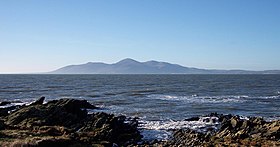Mountains of Mourne
| Mourne Mountains | |
|---|---|
| Na Beanna Boirche | |

View of the Mournes from St John's Point, County Down
|
|
| Highest point | |
| Peak | Slieve Donard |
| Elevation | 850 m (2,790 ft) |
| Geography | |
| Sovereign state | United Kingdom |
| Constituent country | Northern Ireland |
| Counties | County Down |
| Geology | |
| Type of rock | Granite |
The Mourne Mountains (pronounced /ˈmɔərn/ MOHRN; Irish: na Beanna Boirche), also called the Mournes or Mountains of Mourne, are a granite mountain range in County Down in the south-east of Northern Ireland. It includes the highest mountains in Northern Ireland and the province of Ulster. The highest of these is Slieve Donard at 850 m (2,790 ft). The Mournes is an Area of Outstanding Natural Beauty and has been proposed as the first national park in Northern Ireland. The area is partly owned by the National Trust and sees a large number of visitors every year. The name Mourne (historically spelt Morne) is derived from the name of a Gaelic clann or sept called the Múghdhorna.
The Mournes are visited by many tourists, hillwalkers, cyclists and rock climbers. Following a fundraising drive in 1993, the National Trust purchased nearly 5.3 km2 (1,300 acres) of land in the Mournes. This included a part of Slieve Donard and nearby Slieve Commedagh, at 767 m (2,516 ft) the second-highest mountain in the area.
The Mourne Wall is among the more famous features in the Mournes. It is a 35 km (22-mile) dry-stone wall that crosses fifteen summits, constructed to define the boundaries of the 36 km2 (8,900-acre) area of land purchased by the Belfast Water Commissioners in the late nineteenth century. This followed a number of Acts of Parliament allowing the sale, and the establishment of a water supply from the Mournes to the growing industrial city of Belfast. Construction of the Mourne Wall was started in 1904 and was completed in 1922.
...
Wikipedia
